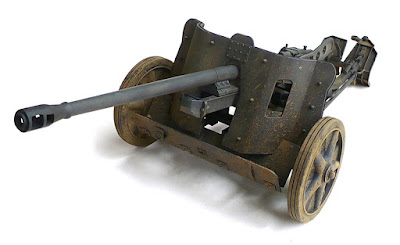Here are some images of Dragon's 1/6 scale 5cm Pak 38.
As is typical with Dragon instructions, (and this kit is no exception) the instructions as usual are incomplete.
So I had venture forth unto the interweb and find some images of a completed model to reference in order to complete it. It's a nice kit though.
From Wikipedia"
The 5 cm Pak 38 (L/60) (5 cm Panzerabwehrkanone 38 (L/60)) was a German anti-tank gun of 50 mm calibre. It was developed in 1938 by Rheinmetall-Borsig AG as a successor to the 37 mm Pak 36, and was in turn followed by the 75 mm Pak 40.
After the Spanish Civil War, the German authorities started to think that a new anti-tank gun would be needed, even though the 3.7 cm Pak 36 had proven to be very successful. They asked Rheinmetall-Borsig to produce a new and more capable AT-gun. They first designed the Pak 37
in 1935, but the German authorities didn't approve it because of its
low capabilities. Rheinmetall-Borsig were forced to create a new gun
under the designation Pak 38, which fitted a new and longer L/60 barrel
and was approved for mass production in 1939.
The Pak 38 was first used by the German forces during the Second World War in April 1941. When the Germans faced Soviet tanks in 1941 during Operation Barbarossa, the Pak 38 was one of the few early guns capable of penetrating the 45 mm (1.8 in) armor of the T-34. The gun was also equipped with Panzergranate 40 APCR shots with a hard tungsten core, in an attempt to penetrate the armor of the heavier KV-1 tank. The Pak 38 was also used in the Atlantic Wall because of its range and anti-tank capabilities, which would have been very useful in destroying allied tanks on the shore.
Although it was replaced by more powerful weapons, it remained a potent and useful weapon and remained in service with the Wehrmacht until the end of the war.
The Pak 38 carriage was also used for the 7.5 cm Pak 97/38 and the 7.5 cm Pak 50(f) guns.
Romania imported in March 1943 a number of 110 Pak 38s. They remained in service until 1954, when the 57 mm anti-tank gun M1943 (ZiS-2) replaced them.







2 comments:
magnificent artist
Sometimes I wonder if it's worth so much work for so little is valued.
Gracias Diego - Me he preguntado eso mismo.
Post a Comment